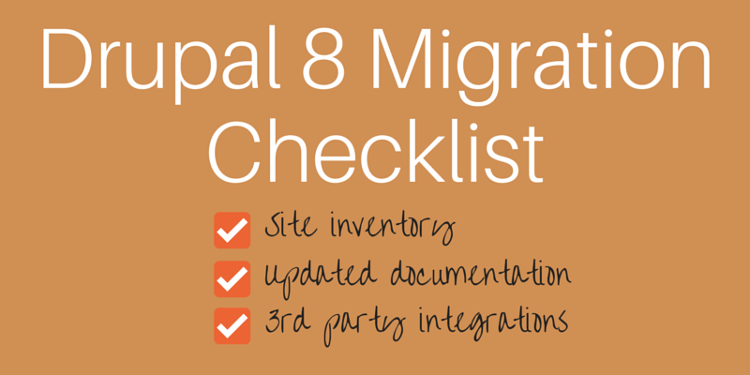Drupal 8 Migration Checklist

Drupal 8 is almost here and there’s a lot excitement in the open-source air! Indeed, the latest version of Drupal promises to be more mobile friendly, have great multi-language abilities, better markup and an enhanced UI experience. All of our Drupal Developers can’t wait for the newest Drop to be released.
However, with the latest Drupal 8 update on the way, we’ve been getting a lot of questions from our customers. The most common questions are in this order: “Does our site need to be upgraded? If an upgrade is essential, then how do I prepare for it?”
If you’re currently on Drupal 7, we’ve got some good news: The Drupal Community will extend Drupal 7 support until Drupal 9 release. Thus, if you’re on Drupal 7, your site may not require an immediate upgrade. However, we do recommend to our customers that they upgrade so that they can reap the benefits of Drupal 8.
If you’re not on Drupal 7, well… You’ll probably need to upgrade your site or, as the Drupal Community puts it, “migrate to Drupal 8.” To help you get started thinking of the Drupal Migration process, we've put together a high level Drupal 8 Migration Checklist. We’ve focused the list to IT and Marketers, since they will be the ones dealing with the migration.
Note: This is not a “technical” list (we’ll save that for another post). Rather, this is a list to get the conversation started and making sure you have a clear plan.
Drupal 8 Migration Checklist For IT
If you've got an in-house IT department, here's what they should start checking off their lists:
- Make sure you have the right people for the job. The more familiar a Drupal Developer is with the Drupal 7, the better. Build a solid team that understands your site functionalities - Both backend and frontend. If you don’t have an internal Drupal Team, then you need to hire Drupal Developers
- Get the non-technical people involved early. Gather together those that will actually be using the website and involve them during the testing phase and record their feedback
- Make sure you have a log of how things on the site are supposed to work. This will make it much easier to troubleshoot if/when things go wrong during the update. Knowing what a module or object is supposed to do will help you fix it if it doesn’t update properly
- Evaluate the site inventory and check if the current inventory will upgrade properly or if you’ll need to change some of the mapped fields
- Note any critical 3rd party integrations. Make sure to check if your 3rd party integrations are supported in Drupal 8 and have future maintenance plans. If they aren't supported, then start researching replacements
- Read up on the known migration errors. There are a lot of "known migration errors" and they're updated often. Being aware of these will save IT a lot of migration headaches
- Have all the documentation. If your IT team plans on writing their own custom migrations, make sure they read the right documentation
Drupal 8 Migration Checklist For Marketing
Nobody knows the significance of an amazing content management system better than the marketing folks. Here’s what marketing needs to do to get ready for the migration:
- Ensure the marketing team has done their research and made a list of what’s working well/what could be improved, what’re the most popular pages/functions/integrations on your site. After it is completed, check the list and make sure everything is there/working
- During the process, create a blueprint of all the assets, especially the functionalities that are the best fit and should be retained.
- Save all the CMS logs that record all the admin issues. This will serve as an invaluable reference during the development and migration. It will be easier for IT to diagnose the errors
- Make sure marketing has a clear game plan on how to effectively use the new Drupal 8 features
And there you have it – a broad overview on migrating to Drupal 8. We saved the super technical stuff for later. Got more questions? Or need help? Let us know in the comments.